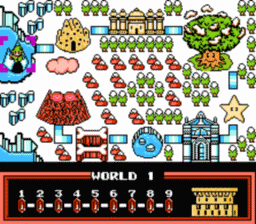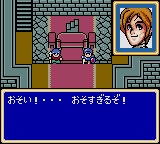
An excerpt from an interview with Kenji Eno, musician, creator of D2, and former boss of Fumito Ueda. Ueda went on to produce games with a definite artistic bent such as Shadow of the Colossus and the Georgio de Chirico inspired Ico. The full 1up interview
Kenji Eno: Usually, mahjong games let you strip a girl if you win the game. The girl has to take off her shirt or whatever, and that was the main concept of most mahjong games. But in my mahjong game, I created it so whenever an oyaji -- the Japanese term for a dirty, middle-aged bastard -- tries to do something bad to a girl, you go and play mahjong to save this girl. So I flipped the whole concept of mahjong games.
1up: Short Warp [A different game] came packaged with a free condom. Were you trying to get gamers to have more sex? Because when we see used copies in stores, the condom is always unused and unopened.
KE: That's sad. [Laughs] This game was made when I was almost on the edge. My mental status was getting very unbalanced, so I wanted to balance myself back by creating a game like this. I was thinking, "If I'm going to create a game like this, I should do something really crazy." And that's how I came up with the idea of this game, and that's why I included a condom. However, I had to make it limited because the packaging was expensive because it came packed with a condom, so the physical dimensions of the package got thicker, and there weren't any packages like that. So the manufacturing fee jumped up, and condoms weren't cheap either, so it was expensive to manufacture the games. If I manufactured too many units, I was going to be deep in the red. So I only made 10,000 copies, and I hand-numbered all of the packages myself.
1UP: Your puzzle game Flopon World seemed flat-out bizarre, especially its packaging. You must've been responsible for that, right?
KE: I basically put bullshit all over that manual. We were explaining things like where the company is, and I had this beautiful picture of Mt. Fuji, and then there's a bullet train and there's like a temple, and I was like, "This is my company." And there were character introductions, and I put stuff like, "This guy's dad is a sumo wrestler and his mom is a ninja." So just, like, total bullshit in the manual.
KE: There's a crazy story behind this. When I was first making D, it had no story. The game was already almost completed, so to put a story in the game, I had to insert it as flashbacks. While I was doing that, I wanted to do some kind of a trick. Back in those days, you weren't allowed to make any violent games -- like, stabbing people inside the game was taboo -- so you weren't allowed to do that. D has cannibalism, which was a total taboo back in the day!
But I wanted to put this in the game, so what I did was I didn't show anyone else in the company those scenes; I was hiding them until the very end. You submit the master, and they check the master and approve the master and put a sticker on it, and this gets sent to the U.S. to get printed. There was a penalty you had to pay if you're late in submitting the master, but you'd also have to deliver it by hand. So, knowing this, I submitted it late on purpose. I submitted a clean one and got it approved. Then I had to bring it to America. So on the plane, I switched the discs and submitted it to 3DO, and it got manufactured like that.
1UP: It's amazing how well the whole game holds together, considering that the storyline and the cut-scenes were like afterthoughts.
KE: There were three phases to D's development. At first, it was just an adventure game. Then I decided to insert a story and turn it into D and make the story that it was Dracula, and this is where the story appeared. But then I thought, "This won't sell; this is too boring," so I put in the third phase, which was violence.
Saturn/Dreamcast, 1997/1999 | Publisher: Sega
Kenji Eno defied fan expectations with this daring adventure game devoid of onscreen visuals, forcing players to carefully listen to dialogue, music, and audio clues in order to solve a melancholy, romance-tinged mystery. A later Dreamcast rerelease added a visual element to the experience: Eno's own photography provided soothing, abstract backgrounds. Real Sound was envisioned as a franchise -- although a sequel was announced, it was never produced.
1UP: After D, you surprised Warp's fans by creating an offbeat Sega Saturn adventure game, Real Sound.
KE: Oh, that's a funky game.
1UP: Yeah, not only was it funky, it was also a game without any visuals. What inspired it, and how did you get Sega to publish it?
KE: After I released D, people were always expecting more CG graphics from me, and I got tired of that. I didn't want people to think that they could predict what Warp would do next. Also, I had a chance to visit people who are visually disabled, and I learned that there are blind people who play action games. Of course, they're not able to have the full experience, and they're kind of trying to force themselves to be able to play, but they're making the effort. So I thought that if you turn off the monitor, both of you are just hearing the game. So after you finish the game, you can have an equal conversation about it with a blind person. That's an inspiration behind this game as well.
So Sega was asking for exclusive rights to the game, and I said, "OK, if you'll donate a thousand Saturns to blind people, then I'll donate a thousand games along with the Saturns." And my condition was that if Sega would go for this idea, I would make that game Sega exclusive. So, that's how this happened. It's been several years now, and of course the contract probably isn't valid anymore, but the reason that I haven't done anything with this game is that I made this promise with Sega back in the day.
1UP: After Enemy Zero, you ported Real Sound to Dreamcast, this time adding visual elements of your photography -- and, weirdly enough, packing a bag of "herb seeds" into each game case. Why seeds, and do you think they'll still grow if we plant them now?
KE: The main reason for including seeds was that Real Sound is a love story, and it's a game that has a totally different concept from my former games, like horror games or the smaller titles, so I wanted people to understand the atmosphere of the game. So I thought that if I included these flower seeds, then that would pass on the image and give the user an idea of what kind of game it is without even explaining the story and all that. That's one of the reasons that I decided to do this. And, also, another reason is that I felt like I wanted the users to grow and support the game.[SEGA fired all third party producers, so Eno was out of a job] I was talking to Joichi, and he was explaining everything he was doing, and he just said, "All right, why don't we work together now?" And that was very rare timing for me because I had no contracts at the time. Like, usually, even when one of my Sega projects got canceled or whatever, I had other contracts going on, so it was very rare where I had a spot where nothing was going on. But that was the very rare spot that I had, and that was the very day that Sega told me the news, so I just decided to do it. And I was feeling that I wanted to get away from games a little bit because, since I was 18, I'd been creating games full time, and I wanted to see what's out there, in the world outside of the game industry, so I thought this was a good chance. That's why I stopped making games.
1UP: During this time, you were focusing on web design, ringtones, vending machines, and other technologies. What are some of your accomplishments during this time that people in the West probably aren't aware of? You showed me your viral [Japanese candy brand] Pinky website, but what are some of the other cool things that you've done?
KE: The first thing that I did -- and probably the biggest thing I did -- was create the system where you could buy a Coke from a Coca-Cola vending machine using your cellphone. And I made a lot of things, like stuff for [Japanese cellphone operator] NTT DoCoMo, and marketing for cigarettes, and I also concept designed a trendy hotel with a hot spring. Then I did the concept design for a restaurant. I did 20 to 30 projects. So my position is a creative producer; I'm usually the person who comes up with the concept of the project, or the creation. I did a lot of random things, but the center-point, the backbone of all this, is communication. Like, the design for communication and interface. So, when I was working on the hot-spring concept, I thought, "How would the people working there and the customers communicate?" I designed the concept for the communication interface in all of these projects.
1UP: One of your animators on Enemy Zero was a young guy named Fumito Ueda, who most people know as being the creator of Ico and Shadow of the Colossus. Did you see his potential, you know, for the future when you worked with him on Enemy Zero?
KE: At the very beginning, he didn't pass the application process at Warp. But I still remember the work that he submitted; it was about a dog running in the rain. His technology as an animator, as a CG artist, wasn't that great, but his ideas and his concepts really struck me, so even though he originally wasn't on the hiring list, I handpicked him because I saw his potential. Not potential as a graphic artist, but his design and concepts struck me, so that's why I picked him out.



























